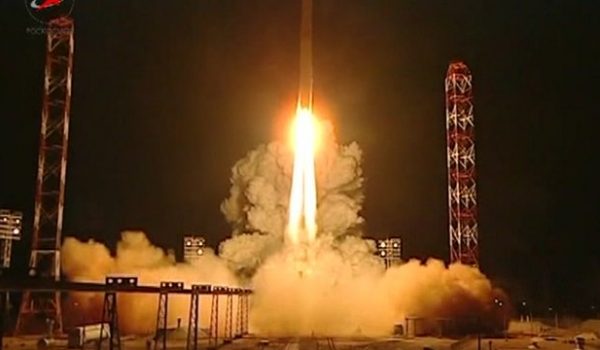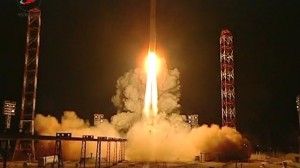

The unmanned Phobos-Grunt probe launching atop a Zenit rocket (Credits: Russian Federal Space Agency).
Efforts to correct the orbit of the Phobos-Grunt probe, trapped in Earth orbit since the on-board boosters failed to fire on November 9, have been hampered by ongoing problems communicating with the spacecraft. There are growing concerns that the probe now represents a significant safety concern, as the 15-ton craft, along with 7 tons of toxic hydrazine fuel, could re-enter Earth’s atmosphere in an as yet-unknown location.
“Overnight, several attempts were made to obtain telemetric information from the probe. They all ended with zero result[s].” Interfax quoted an unnamed source in the Russian space sector as saying. “The probability of saving the probe is very, very small.”
Although it transmitted telemetry confirming normal separation from the launcher after its first orbit, and transmitted confirmation of correct attitude and solar panel deployment after the second orbit, no telemetry data has been received since. Consequently, the exact cause of the malfunction is not yet known.
Early on November 10th, Baikonur ground controllers attempted to reset the flight control computers, and were planning to repeat the process the following evening. One theory suggests that the computer had reset into a pre-launch state, and is currently awaiting a command to restart the flight program. However, attempts by ESA to communicate with the probe from ground stations in both Australia and Kourou were unsuccessful. An unnamed source on the Novosti Kosmonavtiki forum has theorized that the low-gain antenna, the main method of communicating with the onboard flight computers, may have been “abstracted by the external tank of the probe’s main propulsion unit.”
Ground controllers in Baikonur attempted to contact the probe on the evening of November 10th and according to unofficial reports, successfully sent a signal directly to the probe’s on-board transmitter, bypassing the normal methods of communication. Although it was hoped that this would enable radio measurements of the probe’s trajectory, no signal was returned from the transmitter. The controllers are also unable to communicate with the probe’s high-gain antenna, as it is in the stowed configuration for the initial phases of the mission.
If communications cannot be re-established to the probe, controllers will not be able to perform any corrections before it re-enters Earth’s atmosphere. According to a report by RT, a NASA expert has referred to the probe as “the most toxic falling satellite ever”. An unnamed source told the RIA Novosti news agency that if efforts to re-initiate contact with the probe fail, the re-entry could occur sometime in December.
This latest incident continues a string of high-profile Roscosmos failures, including a recent Soyuz incident that temporarily halted traffic to the International Space Station.
The video below is a report by RT on the possibility of the probe re-entering the atmosphere.
[youtube http://www.youtube.com/watch?v=p06p0kyfpv0]

















































































































![A trajectory analysis that used a computational fluid dynamics approach to determine the likely position and velocity histories of the foam (Credits: NASA Ref [1] p61).](https://www.spacesafetymagazine.com/wp-content/uploads/2014/05/fluid-dynamics-trajectory-analysis-50x50.jpg)



Leave a Reply